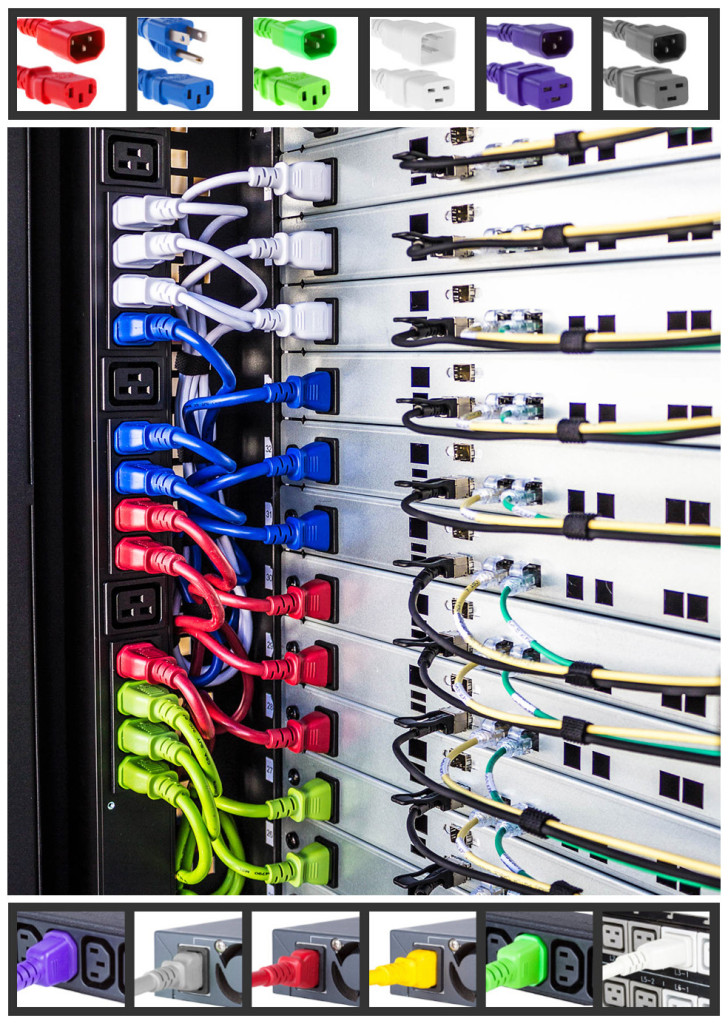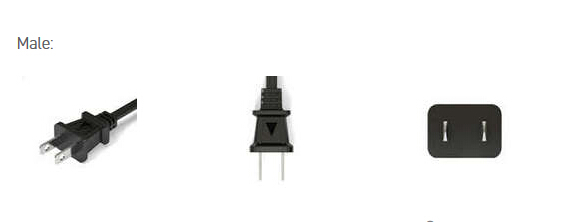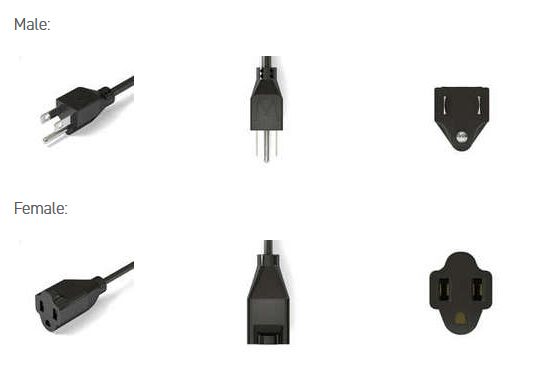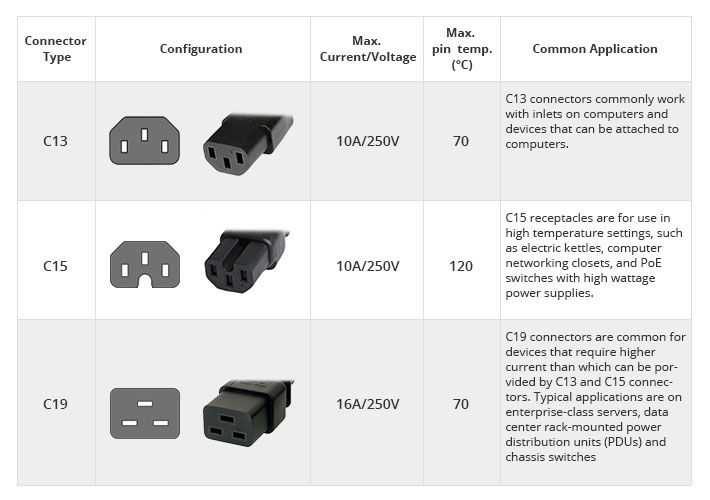NEMA and IEC are two power cord types which have been used a million times in our lives. NEMA, namely National Electrical Manufacturing Association, is the industry group that sets standards for use in electrical products. And IEC (International Electro technical Commission) is a non-profit & non-govt organization that publishes international standards for AC interconnections between equipment. Both of them has some different variaties. This article introduces commonly used NEMA and IEC power cord types, and as well as some buying tips.
Where Thers’s Power, There’s a Power Cord
Power cord is a line cable or main cable that contains a pair of connecting couplers on either of its ends. Both ends are detachable from the electrical supply and device. It bears the burden of temporarily connecting a portable electronic appliance with the main electrical supply line and can easily and readily pass through a wall socket or an extension cord.

Just as the above image shows, the power cord assembly consists of two major parts. One is the cable plug. It is a male connector. Its use is for connecting the AC outlet to provide electricity. The other is the receptacle on the other end. Receptacle part acts as the female connector, which attaches to the equipment. There are several different types of connectors and interfaces used all over the world. The NEMA and IEC power cord types described here are the commonly used in North America.
NEMA Power Cord Types
The establishment of National Electrical Manufacturing Association (NEMA) certificates various power cord types throughout North American and other countries, ranging in amperages from 15-60, and in voltages from 125-600. Unique, non-interchangeable different plug types are created based on specific amperages or voltages.
There are many variants of the NEMA plugs available in the united states and north America countries, but NEMA 1-15-P & NEMA 5-15-P are the most common among them. NEMA type 1 consists of a round pin or prong right below the two flat prongs, while NEMA type 5 uses a third pin for grounding purposes.
NEMA 1-15-P Power Cord—Two-Pole, No Ground
The NEMA 1-15-P is normally referenced as a two-wire non-grounding device that fits into a standard 110 VAC wall outlet. Rated for 125 V maximum, NEMA 1-15-P has two flat blades, just like the NEMA 5-15 plug, but has no ground pin. The female mating outlet for the 1-15-P is called a 1-15-R (R for “receptacle”). Most current versions of this plug have one blade slightly wider than the other.

Ungrounded NEMA 1 plugs are still popularly used by manufacturers of small appliances and electronic devices because of the design’s low cost and compact size, and they are upward compatible with modern grounded NEMA 5 receptacles.
NEMA 5-15-P Power Cord—Two-Pole with Ground Pin
The NEMA 5-15-P is a 3-prong grounded device which plugs into a standard 110 VAC wall outlet. The connector has two flat parallel blades, with a round ground pin located between and above them. The female mating outlet for the 5-15-P is called a 5-15-R (R for “receptacle”).

IEC Power Cord Types
IEC power cord, either IEC 60320 or IEC 60309, is available in different combination of earthing, for temperatures and specific needs. When using these connecting couplers, the merchants just need to change the power cord that comply with these standards to achieve worldwide compatibility.
IEC 60320 Power Cord
IEC 60320 is recognized as the international standards used by most countries in the world, which specifies non-locking appliance and interconnection couplers for connecting power supply cords to electrical appliances up to 250 volts. The “320” refers to the number of the specification that describes power connectors. Different IEC 60320 power cord types ranging from C1 to C24 are specified for different combinations of current, voltage and temperature. For detailed information, please visit: How Much Do You Know about Power Cords?
 Note: C13, C15, C19 are the most commonly used ones in data centers.
Note: C13, C15, C19 are the most commonly used ones in data centers.
IEC 60320 C13 Vs. C15 Power Cord
Form the above image, we can easily see that IEC C15 is similar to the C13 power cord except for a notch opposite the earth in the C15 connector. In addition, IEC-C15 connectors will work in the C14 inlets however, IEC C13 connectors won’t fit into C16 inlets.
The IEC C15 connectors are specifically designed for higher temperature devices (up to 120°C), for example electric kettles, computing networking closets or server rooms, and PoE (Power over Ethernet) switches with higher wattage power supplies. While the standard IEC C13 power cord that runs everything from desktop/personal computers, monitors, printers and amplifiers to fixed-configuration switches. They are typically rated at 15A/250V (domestically) and 10A/250V (Internationally) with the temperature rating at 70°C.
How to Buy A Right One Among These NEMA & IEC Power Cord Types
It is extremely important to choose the appropriate power cord that will deliver high performance in terms of speed and durability. Following a few simple steps will help you make the right choice.
- Identify the Correct Plug for the Country of Export
When deciding on the correct plug pattern, keep in mind that while some look similar that does not mean it is the right cord for the equipment. For example, removing a NEMA power cord from a cord set made with North American cable and replacing it with a Continental European plug (CEE 7/7 power cord) will not make the cord set acceptable for Europe.
- Confirm the Voltage
The voltage rating for plugs in north America ranges from 100-127 to 200-240. Higher or lower amperage can mean a different plug pattern, even in the same country. It will destroy appliances if the 125 volts power cord is mistakenly inserted into a 220 volts receptacle,
- Check the Current Rating of the Power Cord
Another specification to check is the current rating, the rating for north America are different from other countries 15, 20 and 30.
- Choose the Plug Type, if Utilizing a Cord Set
The number of prongs in a plug varies from 2 to 5. The prongs can be oval, round, straight blade, and rectangular in shape. For North America, there are NEMA 5-15P and NEMA 5-20P. Knowledge of the current rating and voltage can help discern between the four types and choose the correct plug.
Which Power Cord Types Do You Need?
When using power cord, it is essential to protect yourself and your tools with a proper ground system. FS.COM AC power cords e.g. IEC power cords, Locking power cords, NEMA power cords, etc. are available in optimal lengths and various colors. Power cord with one end of NEMA connector and the other end with IEC320 plug, are also designed to meet multiple application environments.



